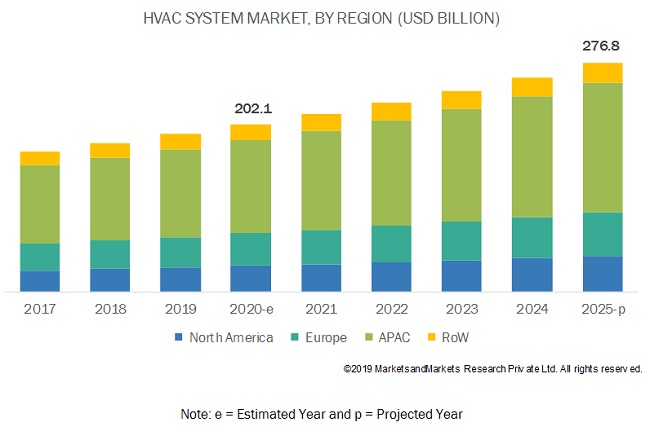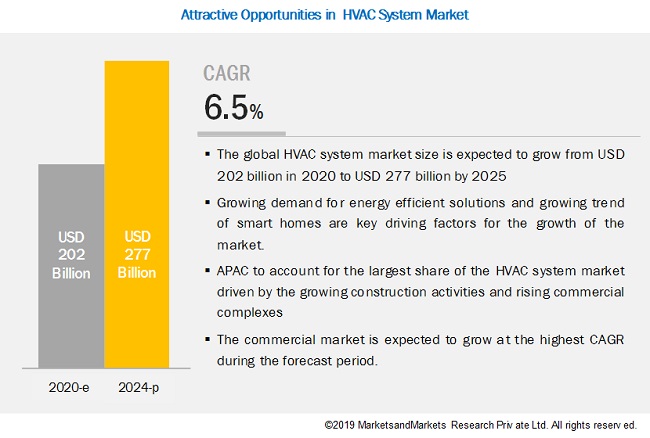[172 Pages Report] The global HVAC system market size is expected to grow from USD 202 billion in 2020 to USD 277 billion by 2025, at a CAGR of 6.5%. The market growth is fueled by growing demand for energy-efficient solutions, rising government incentives through tax credit programs, and an increasing trend of smart homes.
HVAC system market for heating equipment to exhibit high growth during the forecast period
The heating equipment is expected to register the highest CAGR during the forecast period. Heating equipment is an integral part of HVAC systems. These types of equipment are used to heat buildings to a particular temperature, a practice rampant in cold countries. The rapid climate changes and increasing need for renewable energy sources, along with extensive government support in the form of subsidiaries is expected to increase the demand for heating equipment.
Commercial market to lead and exhibit high growth during the forecast period
The commercial segment is expected to lead the global HVAC system market during the forecast period. HVAC systems are used widely in commercial buildings. The office segment is anticipated to hold the largest share of the HVAC system industry within the commercial segment by 2025. HVAC systems provide appropriate temperatures and ventilation conditions at offices, which helps in improving employee productivity, working conditions, and preventing health issues arising from improper humidity levels. Thus, the adoption of HVAC systems is expected to increase in commercial buildings in tandem with the growing building stock.

HVAC system market in APAC to grow at highest CAGR during the forecast period
The HVAC system industry in APAC is expected to grow at the highest CAGR during the forecast period. China, India, and Japan are the major contributors to the growth of this market. Increasing construction activities and rising population are a few of the factors boosting the growth of the HVAC system market in the region.
Key Market Players
As of 2019, Daikin (Japan), Ingersoll Rand (Ireland), Johnson Controls (US), LG Electronics (South Korea), United Technologies (US), Electrolux (Sweden), Emerson (US), Honeywell (US), Lennox (US), Mitsubishi Electric (Japan), Nortek (US), and Samsung Electronics (Korea) were the major players in the global HVAC system market.
Daikin (Japan) is one of the leading players in air-conditioning and fluorochemicals business. It is engaged in general air-conditioning equipment manufacturing with in-house divisions covering both air conditioning and refrigerants. The company operates in business segments, namely, air conditioning, chemicals, and others. The air conditioning segment offers HVAC products such as split/multi-split air conditioners, unitary air conditioners, air to water heat pumps, heating systems, air purifiers, medium/low-temperature refrigeration systems, ventilation products, control systems, chillers, filters, and marine HVAC. Daikin has more than 100 production units around the world and conducts business in more than 150 countries. The company adopted inorganic strategies to continue its growth in the market.
Scope of Report:
|
Report Metric |
Details |
| Years considered for providing market size | 2017–2025 |
| Base year considered | 2019 |
| Forecast period | 2020–2025 |
| Forecast units | Value (USD) in billion/million |
| Segments covered | Heating Equipment, Ventilation Equipment, Cooling Equipment, Application, and Implementation Type |
| Regions covered | North America, APAC, Europe, and RoW |
| Companies covered | Daikin (Japan), Ingersoll Rand (Ireland), Johnson Controls (US), LG Electronics (South Korea), United Technologies (US), Electrolux (Sweden), Emerson (US), Honeywell (US), Lennox (US), Mitsubishi Electric (Japan), Nortek (US), and Samsung Electronics (Korea) |
In this report, the global HVAC system market has been segmented into offering, technique, and geography.
By Heating Equipment
- Heat Pumps
- Furnace
- Unitary Heaters
- Boilers
By Ventilation Equipment
- Air-handling Units
- Air Filters
- Dehumidifiers
- Ventilation Fans
- Humidifiers
- Air Purifiers
By Cooling Equipment
- Unitary Air Conditioners
- VRF Systems
- Chillers
- Room Air Conditioners
- Coolers
- Cooling Towers
By Implementation Type
- New Constructions
- Retrofits
By Application
- Residential
- Commercial
- Industrial
By Region
- North America
- US
- Canada
- Mexico
- Europe
- UK
- Germany
- France
- Rest of Europes
- Asia Pacific
- China
- India
- Japan
- Rest of APAC
- Rest of the World
- Middle East
- South America
- Africa
Critical Questions:
Which equipment of HVAC is expected to have the highest demand in the future?
What are the key trends in the HVAC system market?
What initiatives are being undertaken by major market players?
Which countries are expected to be the highest-revenue generating markets in the future?
How are the disruptions in the different applications expected to impact the market?
HVAC System Market and Top Applications
- Commercial – HVAC systems are widely used in commercial buildings. In commercial buildings, HVAC loads normally represent the highest energy expense. Geographic location plays a significant role; buildings far to the north or south of the world typically have high heating expenses. HVAC systems consume the highest energy in commercial places, about 30% of the energy at a business place is consumed by HVAC systems. Replacing a traditional HVAC system with an advanced and energy efficient one can help save a lot of energy in this sector.
- Residential – HVAC systems provide thermal comfort to occupants of a building or room accompanied by indoor air quality. HVAC systems used for residential purposes maintain a consistent temperature, offer varying humidity levels, and improve air quality. These systems can be classified into local or central systems according to zones, locations, and air distributions. Moreover, growing urbanization has resulted in the increasing adoption of HVAC systems for residential purposes.
- Industrial – The industrial space includes production areas, office areas, and warehousing areas. HVAC systems provide efficient temperatures by maintaining accurate temperatures and humidity as per requirements in the manufacturing zone. Warehouses are important parts of buildings and require temperatures according to the goods stored. An HVAC system is the only solution for warehouses as it maintains the desired temperature, humidity, and ventilation. Moreover, commercial structures can benefit from several interconnected systems that provide heating and cooling to individual floors or other areas.
HVAC System Market and Top Equipment
- Heating Equipment– Heating equipment is an important part of HVAC systems. These types of equipment are used to heat up buildings to a particular temperature. HVAC systems heat up the environment by either generating heat within the building or pumping the warm external air into the building. The heating equipment includes heat pumps (air-to-air heat pumps, air-to-water heat pumps, and water-to-water heat pumps), furnaces (oil furnace, gas furnaces, and electric furnaces), unitary heaters (gas unit heaters, oil-fired unit heaters, and electric unit heaters), and boilers (steam boilers and hot water boilers).
- Ventilation Equipment – The ventilation process removes the unpleasant smell and excessive moisture from the air in an indoor space and introduces fresh air. It helps in maintaining the internal temperature, replaces oxygen, and prevents the accumulation of dust and contaminants. The ventilation equipment includes air-handling units (AHU), air filters, dehumidifiers, ventilation fans, humidifiers, and air purifiers.
- Cooling Equipment – Cooling systems are used to lower the temperature and to enable the proper distribution of air and the control of humidification in a space. Cooling systems are available in various forms, from portable systems to massive systems designed to cool the entire space. Cooling systems are mostly used in the summers to maintain the comfort level of an enclosed space by regulating the warm air with the introduction of conditioned air. Cooling equipment has been segmented into unitary air conditioners, VRF systems, chillers, room air conditioners, coolers, and cooling towers.
Post time: Sep-09-2020









